

Aéronautique et Aviation, Série B (France)
By: John A. Shupek (Skytamer Images)

Series Title: Aéronautique et Aviation, Série B
Cartophilic Reference Number: unknown
Issued by: Bozon-Verduraz
Country of origin: France
Year issued: 1927
Type of card: Foods issue
Number of Cards: 56
Numbering: B.1 to B.56
Card Dimensions: 74.4 × 48.3 mm (nominal)
Checklist: Download
Overview
During the late 1920s, a food stuff manufacturer, Bozon-Verduraz, Paris, France, issued three series of trading cards in their “Collection BOZON-VERDURAZ”:
- 1926 “Costumes Militaires, Série A”
- 1927 “Aéronautique et Aviation, Série B”
- 1928 “Aviation, Séries C”
The same three sets were issued by Savoy Products, Ltd., London, England in their “SAVOY PRODUCTS ”Collection”.
- 1926 “Military Uniforms, Series A” (SBS-1-1)
- 1927 “Aerial Navigation, Series B” (SBS-1-2)
- 1928 “Aerial Navigation, Series C” (SBS-1-3)
Historical Sidenote
At this time, we are assuming that the “Bozon-Verduraz” company was connected in some way to Lieutenant Jean Seraphin Benjamin Emmanuel Bozon-Verduraz. We’re not sure was his exact role was. We would appreciate any insight into the history of the firm.
Lieutenant Jean Seraphin Benjamin Emmanuel Bozon-Verduraz was a French flying ace during World War I. A prewar soldier, he was recalled and switched from cavalry to aviation to achieve 11 confirmed aerial victories. Bozon-Verduraz joined the French military on 1 October 1910. On 3 April 1911, he was promoted to enlisted Brigadier. On 25 September 1912, on the day he was released from duty, he was also promoted to Maréchal-des-logis. He was recalled to duty when World War I began. After a requested transfer to aviation, he went to Crotoy for pilot’s training. After advanced training at Bourget, he received Pilot’s Brevet No. 2437 on 19 January 1916. On 10 March, he was assigned to Escadrille C11 (the “C” denoting the squadron’s use of Caudrons). He was injured in an accident on 12 May 1916. He was promoted to Adjutant on 21 November 1916.
On 28 May 1917, he went to fighter school; by 15 June, he was a Nieuport pilot with Escadrille 3. He was commissioned a Sous lieutenant on 11 July. Bozon-Verduraz scored his first aerial triumphs on 16, 17, and 20 February 1918. He was subsequently appointed a Chevalier in the Legion d’Honneur on 5 April. He promptly tallied two more victories in April, becoming an ace on the 21st. After scoring thrice more in May, on 1 July he was appointed to command a SPAD squadron, Escadrille 94. Subsequently, he was promoted to temporary Lieutenant on the 18th. Leading from the front, Bozon-Verduraz scored three more times with his new escadrille. He finished out his war with 11 confirmed victories scored in logging over 683 hours flight time.
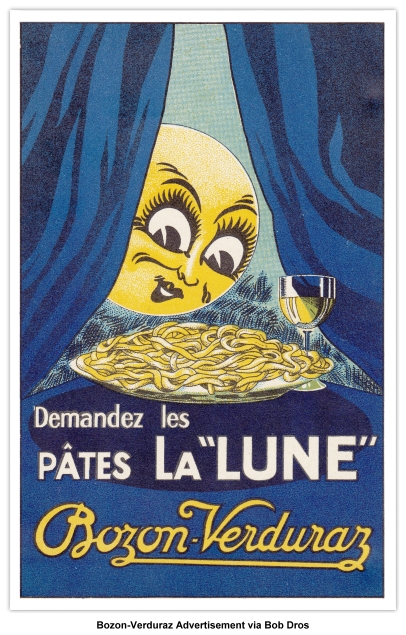
“Aéronautique et Aviation, Série B”
During 1927, Bozon-Verduraz, issued their first 56-card “Aéronautique et Aviation, Série B” aviation related trading card set. The color artwork on the fronts of the cards are presented in both the “landscape” and “portrait” formats. The color artwork features a chronology of aviation events. The card fronts have a generous white border surrounding the artwork image and are divided into the following three vertical components:
- The product identifier “Collection BOZON-VERDURAZ” is located within the top white border.
- The color artwork is located in the center, and also includes the card number, i.e. “;B.18”.
- The card title is centered within the white border at the bottom of the card. The title also serves as the descriptive text since the backs of the cards are non-descriptive.

The backs of the cards are generic with the exception of the card number and card serial number. The card backs are presented in a “portrait” format and are divided into the following five vertical components:
- The set title “Aéronautique et Aviation”.
- The set series and card number: “Série B-18”.
- The descriptive text including an album offer for the set.
- The company’s logo: Bozon-Verduraz.
- The company’s address: 52, Avenue Daumesnil, Paris (12º)
- The card’s six digit serial number: i.e. “283 282”
- Note that the below card has been voided with the “BV” punch.

“Punched” Cards
Bob Dros¹ gave us some insight into the “punched” cards in this series. It appears that when the cards were returned to Bozon-Verduraz in exchange for gift promotions, the cards were voided by punching out the letters “BV” through the cards. The cards were subsequently returned to the customer along with their gift item(s). The British Savoy Products, Ltd. “Aerial Navigation, Series B” (SBS-1-2) set was treated in a similar manner by punching out a “S” for “Savoy” through the card. Examples are shown below.


Image Guide
Thanks to Bob Dros¹ of Bel-Air Models of Amsterdam, Netherlands and Pieter van der Zwaart², Borne, The Netherlands, we are pleased to present a complete image guide for the “Aéronautique et Aviation, Série B” by Bozon-Verduraz. Behind each thumbnail image is a 600-dpi image that you may access.





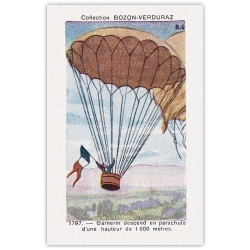
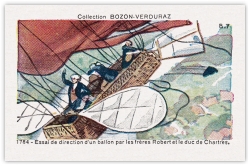






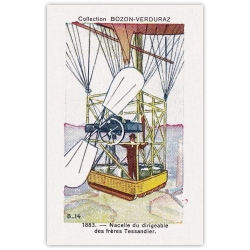

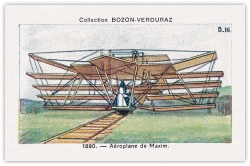
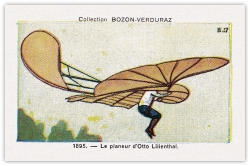

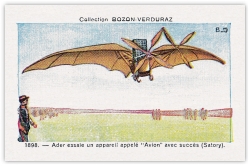



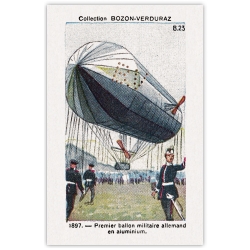



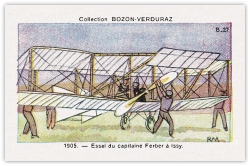
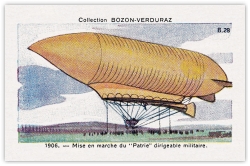

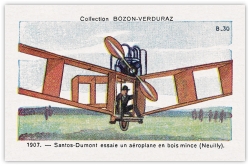

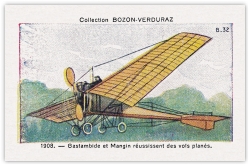
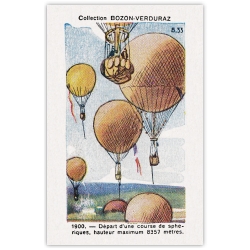
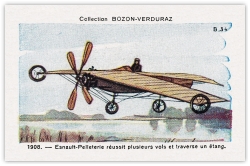
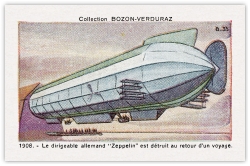




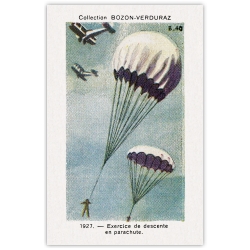






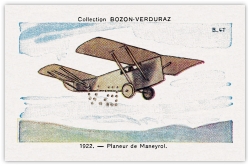



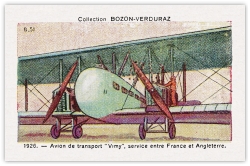
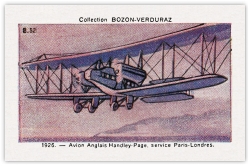

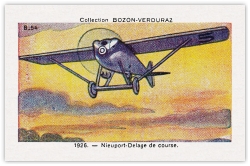


Album
A very special thanks to Bob Dros¹, Amsterdam, for sharing his “Aéronautique et Aviation, Série B” album with us. The attractive, functional and whimsical album is presented in a “landscape” format with slots for each of the 56 cards in the set. Each page holds 8 cards. Behind each of the album image is a 300-dpi image that you may access.

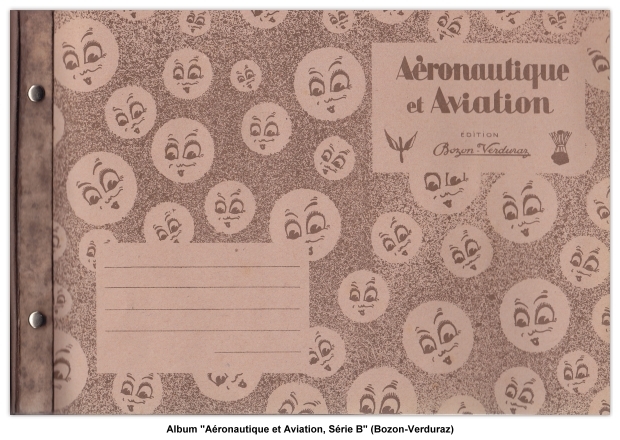
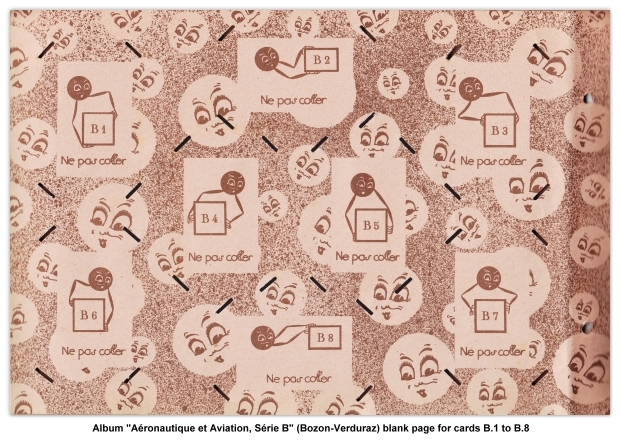
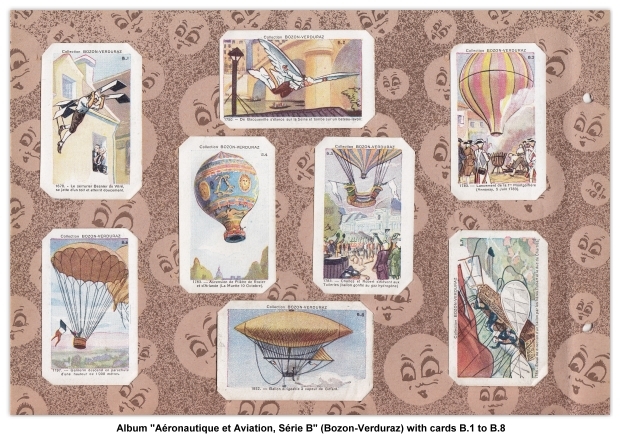




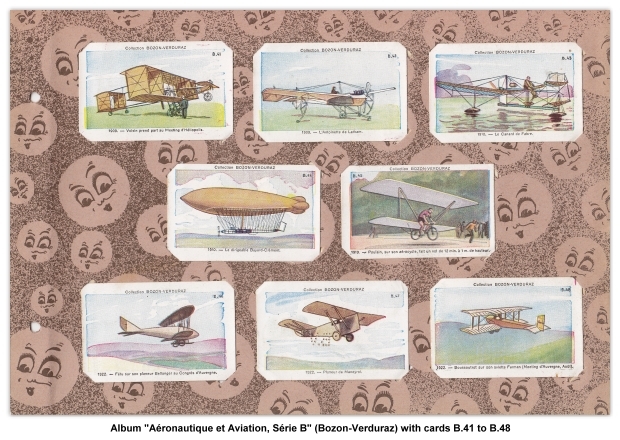

Series Checklist
We have included the following two versions of the checklist: (1) the web version shown below, and (2) an Adobe® Acrobat® PDF 8½ x 11 inch format checklist. Skytamer Archive subscribers may access, download and print out this checklist by entering their username and password when prompted.
| 1927 “Aéronautique et Aviation, Série B” Bozon-Verduraz, Paris, France Checklist | ||||||||||||||||||||||||||||||||||||||
|---|---|---|---|---|---|---|---|---|---|---|---|---|---|---|---|---|---|---|---|---|---|---|---|---|---|---|---|---|---|---|---|---|---|---|---|---|---|---|
| № | x | Card Title | ||||||||||||||||||||||||||||||||||||
| B.1 | 1678. — Le serrurier Besnier de Vitré, se jette d’un toit et atterrit doucement. | |||||||||||||||||||||||||||||||||||||
| B.2 | 1750. — De Bacqueville s’élance sur la Seine et tombe sur un bateau-lavoir. | |||||||||||||||||||||||||||||||||||||
| B.3 | 1783. — Lancement de la 1re Montgolfière (Annonay, 5 Juin 1783). | |||||||||||||||||||||||||||||||||||||
| B.4 | 1783. — Ascension de Pilâtre de Rozier et d’Arlande (La Muette 10 Octobre). | |||||||||||||||||||||||||||||||||||||
| B.5 | 1783. — Charles et Robert s’élèvent aux Tuileries (ballon gonflé au gaz hydrogène). | |||||||||||||||||||||||||||||||||||||
| B.6 | 1797. — Garnerin descend en parachute d’une hauteur de 1000 metres. | |||||||||||||||||||||||||||||||||||||
| B.7 | 1784. — Essai de direction d’un ballon par les frères Robert et le duc de Chartres. | |||||||||||||||||||||||||||||||||||||
| B.8 | 1852. — Baloon dirigeable à vapeur de Giffard. | |||||||||||||||||||||||||||||||||||||
| B.9 | 1862. — Plaistier et Coxwell s’élèvent de 10.000 mètres et ont failli périr. | |||||||||||||||||||||||||||||||||||||
| B.10 | 1870. — Rollier et Bezier montant un ballon-poste vont atterrir en Norvège (Déc.). | |||||||||||||||||||||||||||||||||||||
| B.11 | 1874. — De Groff se jette d’un Ballon avec un planeur et se tue (Londres). | |||||||||||||||||||||||||||||||||||||
| B.12 | 1875. — Le “Zénith” va en 23 h. de Paris à Arcachon (Record de durée). | |||||||||||||||||||||||||||||||||||||
| B.13 | 1878. — Le ballon captif de Giffard au Carrousel montant à 600 mètres. | |||||||||||||||||||||||||||||||||||||
| B.14 | 1883. — Nacelle du dirigeable des frères Tessandier. | |||||||||||||||||||||||||||||||||||||
| B.15 | 1884. — Dirigeable des capnes Renard et Krets à moteur électrique (Meudon). | |||||||||||||||||||||||||||||||||||||
| B.16 | 1890. — Aéroplane de Maxim. | |||||||||||||||||||||||||||||||||||||
| B.17 | 1895. — Le planeur d’Otto Lilienthal. | |||||||||||||||||||||||||||||||||||||
| B.18 | 1898. — Lenglay fait un vol de 900 mètres avec son avion (Potomac). | |||||||||||||||||||||||||||||||||||||
| B.19 | 1898. — Ader essaie un appareil appelé “Avion” avec succès (Satory). | |||||||||||||||||||||||||||||||||||||
| B.20 | 1901. — Santos-Dumont parti de St-Cloud, double la tour Eiffel en 30' (19 Oct). | |||||||||||||||||||||||||||||||||||||
| B.21 | 1902. — Le “Jaune” de Lebaudy, va de Paris à Rouen en 3 heures. | |||||||||||||||||||||||||||||||||||||
| B.22 | 1905. — Essai d’Archdeacon avec un planeur (Issy). | |||||||||||||||||||||||||||||||||||||
| B.23 | 1897. — Premier ballon militaire allemand en aluminium. | |||||||||||||||||||||||||||||||||||||
| B.24 | 1897. — Andrée part pour le Pôle Nord, II a disparu. | |||||||||||||||||||||||||||||||||||||
| B.25 | 1898. — Varidé tente des voyages polaires. | |||||||||||||||||||||||||||||||||||||
| B.26 | 1899. — Pilcher essaie un planeur et se tue (Angleterre). | |||||||||||||||||||||||||||||||||||||
| B.27 | 1905. — Essai du capitaine Ferber à Issy. | |||||||||||||||||||||||||||||||||||||
| B.28 | 1906. — Mise en marche du “Patrie” dirigeable militaire. | |||||||||||||||||||||||||||||||||||||
| B.29 | 1906. — Le dirigeable de H. de la Vaulx évolue pendant plusieurs heures. | |||||||||||||||||||||||||||||||||||||
| B.30 | 1907. — Santos-Dumont essaie un aéroplane en bois mince (Neuilly). | |||||||||||||||||||||||||||||||||||||
| B.31 | 1908. — Wilbur Wright faint 90 Km. en 1 h. 21" 25" (Camp d’Auvours). | |||||||||||||||||||||||||||||||||||||
| B.32 | 1908. — Gastambide et Maggin réussissent des vols planés. | |||||||||||||||||||||||||||||||||||||
| B.33 | 1900. — Départ d’une course de spheriques, hauteur maximum 8357 metres. | |||||||||||||||||||||||||||||||||||||
| B.34 | 1908. — Esnault-Pelleterie réussit plusieurs vols traverse un étang. | |||||||||||||||||||||||||||||||||||||
| B.35 | 1908. — Le dirigeable allemand “Zeppelin” est détruit au retour d’un voyage. | |||||||||||||||||||||||||||||||||||||
| B.36 | 1908. — L’avion Voisin-Delagrange. | |||||||||||||||||||||||||||||||||||||
| B.37 | 1908. — Le dirigeable “Ville de Paris” va de Paris à Verdun. | |||||||||||||||||||||||||||||||||||||
| B.38 | 1909. — Demoiselle Santos-Dumont. | |||||||||||||||||||||||||||||||||||||
| B.39 | 1909. — Blériot réussit la traversée de la Manche. | |||||||||||||||||||||||||||||||||||||
| B.40 | 1927. — Exercise de descente en parachute. | |||||||||||||||||||||||||||||||||||||
| B.41 | 1909. — Voisin prend part au Meeting d’Héliopolis. | |||||||||||||||||||||||||||||||||||||
| B.42 | 1909. — L’Antoinette de Latham. | |||||||||||||||||||||||||||||||||||||
| B.43 | 1910. — Le Canard de Fabre. | |||||||||||||||||||||||||||||||||||||
| B.44 | 1910. — Le dirigeable Bayard-Clément. | |||||||||||||||||||||||||||||||||||||
| B.45 | 1919. — Poulain, sur son aérocycle, fait un vol de 12 min. à 1 m. de hauteur. | |||||||||||||||||||||||||||||||||||||
| B.46 | 1922. — Fétu sur son planeur Bellanger au Congrès d’Auvergne.>
| B.47 | 1922. — Planeur de Maneyrol. | B.48 | 1922. — Bossoutrot sur son aviette Farman (Meeting d’Auvergne, Ao’ût). | B.49 | 1925. — Hélicoptèr Pescara. | B.50 | 1926. — Lancement d’un hydravion, pat catapulte, du pont d’un crolseur. | B.51 | 1926. — Avion de transport “Vimy”, service entre France et Angleterre. | B.52 | 1926. — Avion Anglais Handley-Page, service Paris-Londres. | B.53 | 1926. — Avion de bombardement Levasseur. | B.54 | 1926. — Nieuport-Delage de course. | B.55 | 1927. — Carcasse métallique du fuselage d’un avion. | B.56 | 1927. — Le “Los Angeles”, dirigeable militaire des Etats-Unis. | — | Collection Bozon Verduraz Album Front Cover "Mes Belles Images / My Beautiful Pictures". | — | Album "Aéronautique et Aviation, Série B" (Collection BOZON-VERDURAZ) | | |||||||||||||
Contributors
|
Bob Dros — Bob was born on a Dutch island that had a small airfield and a gunnery range for naval aircraft. Bob experienced his first signs of aviation addiction at age of 7, when he was seeing and hearing “Spitfires” that flew overhead from the nearby airstrip as target tugs. Bob’s childhood memories include seeing and hearing the low flying Dutch naval “Avengers”, “Harpoons”, “Neptunes” and “Sea Furies” target practicing just five miles from his island village. Bob started off his airplane Bob’s interests also include music. His first group in 1962 was “The Typhoons”. Starting in 1974, Bob played drums in one of Holland’s best known blues bands “Barrelhouse”. During 1978 “Barrelhouse” invited the American blues guitarist Albert Collins to Holland and toured and recorded with him. “Barrelhouse” also worked with B.B. King on his European tours. During 2014, “Barrelhouse” did a 40th Anniversary Tour in Europe. Bob studied psychology from 1968-1975, got his degree and worked for two years, but his love of music pulled him back into the music world. During 1986, Bob started his own business … Bel Air Models. At first, Bel-Air Models specialized in miniature musical instruments, like electric guitars, drums and classical instruments. However, Bob’s lifelong love affair with aviation later changed the focus of Bel-Air Models completely to model aircraft types. Bel-Air Models specializes in odd types of model aircraft, which are not available on the regular model aircraft market, such as the wonderful airliner designs from the Inter-War years. Bel-Air Models mostly takes commissions from specialist collectors and constructs the models by hand from solid Perspex or Plexiglas. So far, Bel-Air Models has done more than 150 aircraft types, many of them twice, three times and even 25 times, dependent on their popularity. In Bob’s spare time, he writes short articles about model history for a periodic of a group of enthusiast flying model airplane owners. |
| ★ ★ ★ ★ ★ |
|---|
|
Pieter van der Zwaart was born in Amstelveen, a village near by Amsterdam, about 1 mile from Schiphol, now known as the Amsterdam Airport. At that time, aviation in the Netherlands was still recovering from the devastation of World War II. As a very young boy, Pieter’s family collected airplane cards for two albums “Vliegende Vleugels” (Flying Wings) written by the famous Dutch aviation author C. van Pieter’s father was a great admirer of Dr. Albert Plesman, a Dutch aviation pioneer and founder of KLM, the oldest airline in the world still operating under its original name. Together they made several visits to Schiphol and as a young boy he saw the KLM-fleet developing from Douglas DC-4s to DC-6s to DC-7s to Lockheed “Constellations” and later on to the beginning of the jet-age with Douglas DC-8s and DC-9s. As a working student, with Avis® Rent A Car at Schiphol, he even witnessed the first arrival of the Boeing 747 at Schiphol. During his working career and growing a family, for many years there was no time for his aviation interests. But during the last two decades, he revived his interest in Aviation, especially by collecting card albums in that theme from all over the world. On the same terms he also collects card albums on cars. At that time, Pieter also revived his musical interests. After playing trumpet in his youth, he started studying the bass tuba and now plays in several orchestras and occasional groups at the top amateur level in the Netherlands. Pieter has a collection of about 400 card albums from all over the world, evenly distributed about cars and planes. From all the continents only Asian albums are still missing. And after a few decades of collecting he still isn’t sure whether the albums are the best things in collecting or the contacts one makes during trading and exchanging information. Some of his interests in aviation are shared with his son, and together they visit aviation museums in and around the Netherlands. His son is a very enthusiastic advanced flight simulator player on his PC and Pieter hopes to be tutored in flying by him soon. After receiving his degree in Mechanical Engineering and Mathematics, Pieter had a career in Math Education and Curriculum Development. After his retirement, Pieter is still involved in the development of math tests for secondary education. |
| ★ ★ ★ ★ ★ |
|
John Shupek — John is retired Aeronautical/Aerospace Engineer that lives in Southern California. John’s 36 year aerospace career/adventure started in the mid-1960s when he worked for Pratt & Whitney at their “FRDC” … Florida Research and Development Center, West Palm Beach, Florida. John was part of the P&W jet engine design team for the CIA/USAF’s Lockheed A-12/SR-71A “Oxcart/Blackbird” engines (J58/JT11D-20). He also worked on the RL-10 rocket engine and the JTF-17A which was P&W’s entry into the United During John’s career at Northrop Grumman he served for five years as Northrop’s “Vintage Aircraft Club” Commissioner and the Curator and Webmaster for the Western Museum of Flight in Hawthorne, California. Several years later, John was the volunteer webmaster (for about 3 years) for the Yanks Air Museum, Chino, California. He also served as President and webmaster for two different NPO’s after his retirement. The Whittier Historical Society & Museum and Whittier Meals on Wheels. John’s love of aviation history and aviation photography lead to the establishment of this Skytamer.com website in 1998. The Skytamer.com site has continued to expand and will always grow and will never be completed. It’s sort of analogous to a snowball rolling down a hill without any trees to stop it. In approximately 2002, John remembered that he had collected Topps “Wings” (ACC# R707-4) airplane trading cards while in High School. Somehow the cards had disappeared over the years. So at this point, he started to re-collect airplane trading cards via eBay and become an airplane card “Image Collector” rather than a “Card Collector” per se. After John scans an airplane card for the website, he has no further use for it and he puts it back into circulation via eBay. John’s mission statement for the Skytamer.com is basically to restore and preserve high-quality card images/artwork associated with the various airplane card sets from the early 1900s to the present. These cards are wonderful historical “snapshots” into aviation history showing which aviation events and aircraft were important at that point in time. For the Skytamer.com website, basically if it is a trading card collection that features things that fly, but doesn’t have feathers, it's eligible for the consideration on the Skytamer.com website. John always welcome inputs and high resolution scans (600-dpi) that can be used on this website. John can be reached via the “Contact Us” navigation button on the left. |
References
- Dros, Bob (Bel-Air Models, Amsterdam, The Netherlands), Card and album scans
- Pieter van der Zwaart, Borne, The Netherlands, Card and album scans
- Shupek, John. Skytamer Images, Card scans from the Skytamer Images Collection
Copyright © 1998-2020 (Our 22nd Year) Skytamer Images, Whittier, California
ALL RIGHTS RESERVED
























































 trading card collection by collecting the wonderful five series of Croydon aircraft cigarette cards, and the Van Dijk’s Gouda’s Roem albums “History of Aviation” and “World Aviation” and
trading card collection by collecting the wonderful five series of Croydon aircraft cigarette cards, and the Van Dijk’s Gouda’s Roem albums “History of Aviation” and “World Aviation” and 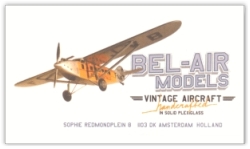
 Steenderen and issued by Theodorus Niemeyer, producer of coffee and tea.
Steenderen and issued by Theodorus Niemeyer, producer of coffee and tea. States’ SST competition between Boeing and Lockheed. Several years later, John moved back to California and worked at the AiResearch Mfg. Company at LAX and Torrance. He originally worked on the thermal design of the HRE (Hypersonic Ramjet Engine) which was a supersonic combustion Mach 7 ramjet engine that was to be tested on the North American X-15. John did about three more years of jet engine design work before he disappeared for 13 years into the classified DOE “GCEP” (Gas Centrifuge Enrichment Plant) Atomic Energy program for the enrichment of U235. After the GCEP program was cancelled by the DOE in 1985, John was hired by Northrop Aircraft to do the thermal design for Northrop’s entry into the ATF (Advanced Tactical Fighter) competition, the Northrop YF-23A “Black Widow II” stealth supercruise fighter. He also worked on the Northrop Grumman B-2A “Spirit” stealth bomber. After several years on a classified stealth missile program, John worked the remainder of his Aerospace career as one of Northrop Grumman’s Program Directors on the United States Navy’s F/A-18E/F “Super Hornet” jet fighter program.
States’ SST competition between Boeing and Lockheed. Several years later, John moved back to California and worked at the AiResearch Mfg. Company at LAX and Torrance. He originally worked on the thermal design of the HRE (Hypersonic Ramjet Engine) which was a supersonic combustion Mach 7 ramjet engine that was to be tested on the North American X-15. John did about three more years of jet engine design work before he disappeared for 13 years into the classified DOE “GCEP” (Gas Centrifuge Enrichment Plant) Atomic Energy program for the enrichment of U235. After the GCEP program was cancelled by the DOE in 1985, John was hired by Northrop Aircraft to do the thermal design for Northrop’s entry into the ATF (Advanced Tactical Fighter) competition, the Northrop YF-23A “Black Widow II” stealth supercruise fighter. He also worked on the Northrop Grumman B-2A “Spirit” stealth bomber. After several years on a classified stealth missile program, John worked the remainder of his Aerospace career as one of Northrop Grumman’s Program Directors on the United States Navy’s F/A-18E/F “Super Hornet” jet fighter program.